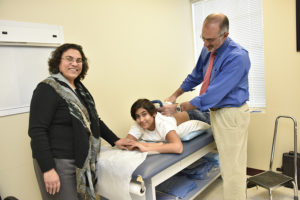
AÂ pediatric orthopedic surgeon at Maria Fareri Children”™s Hospital in Valhalla is using a new technology-aided surgical procedure to spare young patients the pain, physiological risks and social setbacks of traditional treatment for scoliosis, a curvature of the spine that affects an estimated 6 million to 9 million people in the U.S., most of them children.
Dr. Damon DelBello, an attending orthopedic surgeon at Westchester Medical Center and the children”™s hospital on the WMC campus, has introduced a less invasive procedure to correct the spinal condition that requires fewer surgeries and less exposure to anesthesia for children, minimizes the risk of infection and reduces anxiety in his patients.
In traditional treatment for pre-adolescents with early-onset scoliosis, surgeons insert “growing rods” in the patient that are attached to the spine with adjustable screws above and below the spinal curve. As the child grows, surgeries are needed every six months to lengthen the rods.
At Maria Fareri, DelBello has made use of a medical device, Magnetic Expansion Control Rods, part of a magnetic-technology treatment system that spares growing children multiple follow-up invasive surgeries once the MAGEC rods are implanted. Instead, the magnetically controlled rods are lengthened every three months by the surgeon using an external remote controller.
“The end result of the two procedures is the same from a mechanical point of view, but from the patients”™ point of view, they don’t suffer the same physiological risks,” DelBello said. “I had several kids who were very upset and anxious about their traditional growth rods and when we changed them to the MAGEC rods the negative physiological effects ended.”
Reaching adolescence and skeletal maturity, patients receiving either the traditional or magnetic rod procedure typically undergo a spinal fusion surgery to permanently correct the spine with a titanium rod.
The MAGEC spinal bracing system was approved three years ago by the U.S. Food and Drug Administration for use in pre-adolescents with severe progressive spinal deformities. Newburgh resident Grace Ramos, whose 12-year-old son, Miguel, is a patient of DelBello”™s, said her family is “very blessed” that the new technology was approved for use and adopted by Miguel”™s pediatric surgeon.
Ramos was in her 23rd week of pregnancy with Miguel when a sonogram led to a diagnosis of infantile scoliosis in her unborn child. Miguel in infancy wore a brace 23 hours a day to stop or slow the progression of the spinal curve, but it had little effect. “The brace works for some kids with minor scoliosis, but when you have 40, 50 or 60 degrees of curvature, you need more than a brace to correct it,” his mother said.
“Miguel is very blessed that these new rods were available at the time that they were or else he would have been one of the children using the painful old procedure,” Ramos said. Dr. Delbello, she said, had his eye on the new procedure that had not yet been approved by the FDA and suggested the Ramos family wait until it became available.
“It pains me that there are children that have to endure painful extending procedures,” Miguel”™s mother said. “Children under the old procedure have to go to the emergency room and go under anesthesia to extend the rods. The child is heavily medicated and has to stay over in the hospital one to two nights after each surgery. There is no attending school during this time and their lives are put on hold. Just as these children are feeling better again, they go back for another one.”
“Miguel sees Dr. DelBello every three months to extend the rods,” said Ramos. “The beauty of these rods is that we schedule an office visit instead of a hospital visit, he is not under anesthesia and it’s noninvasive.”
DelBello said his checkups for patients using the MAGEC rods “are six minutes, compared to an hour and a half procedure followed by an overnight stay with the traditional growth rods.”
The doctor and his just-turned-12 patient have formed a strong bond during those checkups and rod adjustments. “Miguel talks with Dr. DelBello about basketball, sailing and baseball as he turns on a magnetic device that takes 30 seconds to extend each side,” Grace Ramos said.
“I talk to children in a straightforward manner and in an adult way,” said DelBello. “I don’t baby them in any way. They get the same information their parents get. They understand more than we give them credit for.”
Miguel Ramos understands: “I am the luckiest scoliosis patient thanks to Dr. DelBello,” he said.
“We feel that although Miguel was born with scoliosis, our family is very blessed,” said Grace Ramos. “As a mother, I want it to be my mission to show every child with scoliosis these MAGEC rods.”





















That is great! Scoliosis is really bad cause it stops us from doing some physical activities. I hope there are more ways to be discovered to treat Scoliosis. Wihout surgery or planting a metal rod to your back, I don’t think that is comfortable lol. I hope there is another way that a Chiropractician can do to fix it without surgery.